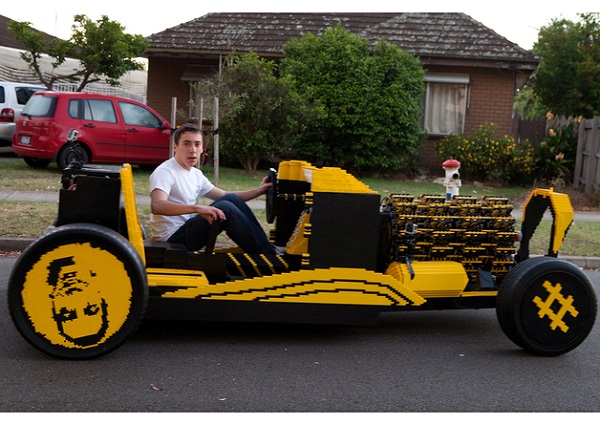Making the plastic, Danish building bricks far more than a child’s plaything, two men have created a working, life-size LEGO car that’s powered by air.
Try using your old Action Men figures for anything other than to reminisce on your childhood and you’d be hard pushed to make use of them and the same goes for playsets that you’ve grown out of and dollhouses that you’ve since substituted for mortgages and the real thing. While there are certainly more than a handful of children’s pastimes that we’ve become too old for, the plastic building blocks – LEGO – are not one of them, with the Danish plaything inspiring just as many adult creators as it does adolescent ones. Now, LEGO has inspired another use, with two people using to to build a life-sized, working car.
Ambitiously, the LEGO car is called the ‘Super Awesome Mini Project’ or ‘SAMP’, by creators Steve Sammartino, an entrepreneur from Australia and Raul Oaida, a self-taught “technology genius” from Romania. It may have that title for its cross-continental exploits alone, as the SAMP was built in Romania before being shipped to Australia, seeing its 500,000+ LEGO pieces do some serious travelling. Underneath SAMP’s hot-rod exterior is the engine which is made up of four orbital engines, 256 pistons and, yet again, more LEGO bricks, seeing the vehicle run on air and reach a speed of 20MPH (it may be faster but the creators are wary of a LEGO “explosion” if they try).
Even more ‘Super’ and ‘Awesome’ yet is how the project came to be. While many projects of this nature go the Kickstarter route, Steve simply sent out a tweet requesting around 20 supporters who were willing to chip-in between $500-$1000 and he was successful, getting over 40 backers to help make SAMP a reality, showing everyone that LEGO bricks aren’t just for children.
Watch a video about the Super Awesome Mini Project below.
https://www.youtube.com/watch?feature=player_embedded&v=_ObE4_nMCjE
We’ll keep you posted once we know more.
Source: Super Awesome Mini Project
Read more on walyou, Electric Cars Can Now Be Charged Via Manhole Covers, Nissan’s Self-Driving Cars Will Rely on 3D Laser Scanners











